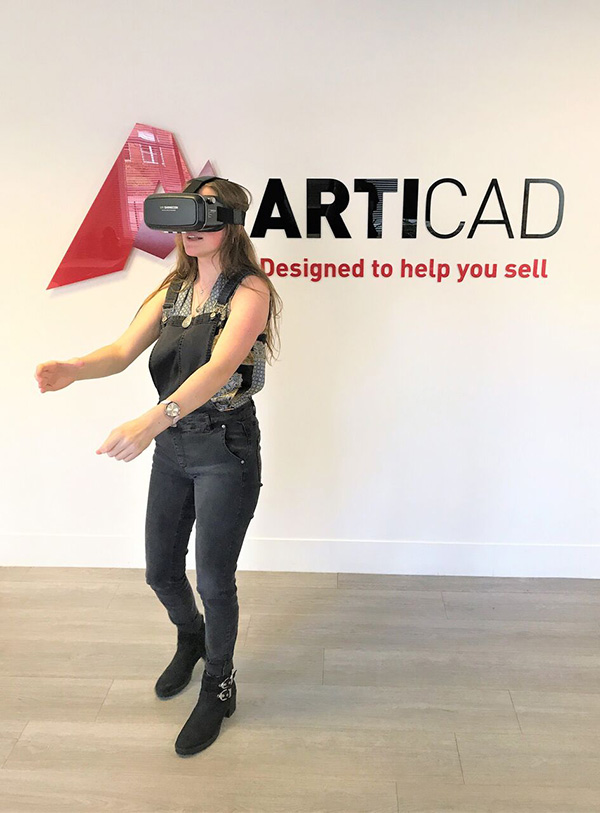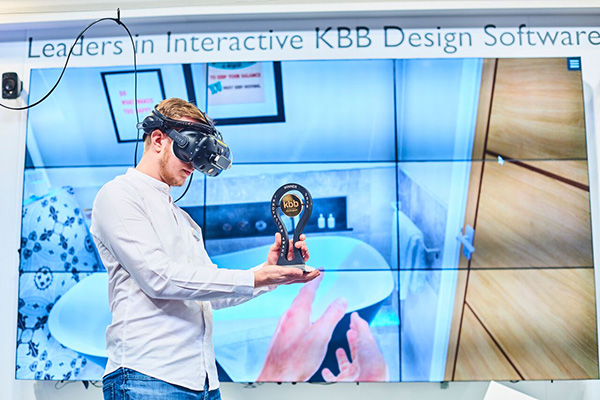Will 3D CAD presentations ultimately be succeeded by immersive buying experiences? Philippa Turrell asks the question.
Where once the hot topic was whether to use traditional hand render skills or CAD, it’s seemingly obsolete as some industry experts would now question are photorealistic 3D presentations enough? CAD is moving off the small screen to become an immersive experience with the advent of augmented reality (AR) and virtual reality (VR). It’s no longer just a sensation for gamers or film-goers, AR and VR is available for kitchen and bathroom design now, and is growing in awareness and use.
Director of ArtiCAD Theresa Turner comments: “Over the last couple of years, we have seen a greater awareness of VR technology – and also witnessed the arrival of Augmented Reality into the kbb arena.” And she continues, explaining how this technology suits the kbb industry: “VR presentations work equally well for large kitchen spaces as well as for the typically more confined and sometimes challenging space of a bathroom.”
Virtual reality
Accomplished bathroom and kitchen designers may be familiar with VR as an integral part of CAD software, such as ArtiCAD Pro or by using Pan 360 with a VR headset. However, there is also the opportunity for a fully immersive experience, as managing director of Virtual Worlds Nathan Mclean comments: “A complete VR system, such as Virtual Worlds 4D, allows users to walk around the space and interact with objects as if they were really there.”
Sponsored Video
He continues: “While inside the virtual world, users can walk around, open cupboards and drawers and even enter ‘inspect’ mode, which allows them to view and individual production in isolation, including key specifications and product videos.”

Virtual Reality is already incorporated into ArtiCAD-Pro software, as standard. And specialist app Pan 360 panoramic viewer, which works on smart devices, can be used as an on-screen presentation on a computer or transformed into an immersive experience using a VR headset.
Designers using ArtiCAD Pro simply need a computer, while its Pan 360, which works on a mobile device, requires the addition of a VR headset. However, Virtual Worlds 4D requires much more. It demands a showroom needing access to a VR headset, video screen and reasonably well powered laptop. It also needs space, around 3sqm, to allow consumers to move around the virtual space. And of course, there is the cost that the technology incurs.
But, and it’s a big but, VR CAD is not a novelty gadget, as more than 200 retailers are already using the Virtual Worlds 4D Theatre. And Teresa Turner of ArtiCAD reports: “We would estimate that some 25% of our customers are now using Pan 360 to help with their presentations, this percentage is growing rapidly.”
VR improves sales
Teresa Turner of ArtiCAD explains why VR has become significant as part of CAD software development: “Virtual reality technology offers those clients (who wish it) to have a fully immersive experience in their proposed new room – to have the impression of actually being within the room, rather than viewing it from outside. For some clients this may add to the realism of the design.”

Winner of the Innovation Award at the recent kbbBirmingham exhibition, Virtual Worlds 4D Theatre allows consumers to walk around a space and interact with objects. They can view an item in isolation, looking at key specifications and view product videos.
And Nathan Mclean of Virtual Worlds states this realism actually helps retailers close more sales: “Displaying a new room in highly immersive virtual reality enables customers to see and live in their design before a brick or tile has been laid. This now only makes them more likely to commit to a sale, but also reduces the chance of buyers’ remorse.” He explains: “You wouldn’t buy a family home if the salesperson was trying to sell you that home by sitting in front of a computer, showing you renders, plans and elevations and telling you in a consultation how many power points your lounge is going to have or how high the ceiling is. That’s information overload.”
To support his premise, Nathan Mclean offers statistics on how his retail network has performed once they have adopted the Virtual 4D Theatre: “Retailers incorporating VR technology frequently report a 50% increase in sales conversions, and up to an 80% conversion rate. On top of this, some retailers have seen a 17-20% rise in order value since bringing immersive, true VR CAD into their showroom.”
Enter augmented reality
And now, VR has been joined by Augmented Reality (AR), which combines computer imagery with real life. Think of the children’s game Pokemon Go or Facebook video chats with filters. Admit it, who hasn’t tried or been tempted to add dog ears with a lolling tongue? In kitchen and bathroom design terms, AR is powerful, as it can allow consumers to see virtual product in their home setting.
It allows retailers to superimpose product into different displays and even increase the number of products available in their showroom, by offering alternatives to the model on display. Nathan Maclean adds: “The problem that a showroom has is that they can’t put everything on display. Our VR and AR are a solution to that.”

Certainly that is the premise behind AiR (Augmented Interactive Reality) technology previewed by Virtual Worlds at kbbBirmingham, which is set for launch in the Spring. By scanning an AiR QR Code in a brochure, the product will lift off the page so the consumer can position the fully-formed item in their own bathroom. Equally, if scanned on a showroom display, the QR Code can contain all the variants of a product, allowing consumers to see all the offerings from one range ‘live’ in the showroom.
Interestingly, experts suggest it’s not a matter of choosing virtual reality over augmented reality or vice versa. Instead, they believe the two technologies can (and arguably) should co-exist in a kitchen or bathroom showroom to capitalise on sales. Nathan Maclean adds: “The next major step is likely to be integrating augmented reality into the sales process. Popularised by Apps such as Pokemon Go, and made more accessible by Apple’s AR kit, AR is another important immersive touch point. We predict retailers will be keen to capitalise on it within their business, thanks to the fact it is so widely used by a large customer base.”
Replacing traditional CAD
So, the question remains will VR and AR ultimately replace more traditional CAD packages? Teresa Turner is neutral in her response, stating: “There are many variables to consider including perhaps the expectations of the client, their age group, whether they can see sufficient detail on a screen or need something more, whether the idea of immersion appeals to them as useful, just a novelty, or something with which they may already be familiar, maybe from computer games.” She continues: “It may be worth considering, however, how many customers for a new kitchen or bathroom design will opt for the full immersive experience, especially if this involves one of the heavier headsets.”
However, Nathan Maclean is much more definite: “At Virtual Worlds, we firmly believe that to buy a new kitchen or bathroom without using immersive VR will soon be considered an unacceptable risk to most consumers. It is therefore becoming increasingly difficult for retailers to ignore VR CAD, and for this reasons it will undoubtedly soon be the standard offering in any kitchen or bathroom showroom.”
Certainly VR and AR can create drama and a memorable shopping sensation, bridging the gap between a wealth of information available on the web with real-life, in-store experience. And as hardware and App technology become available at ever more attractive price points, VR and AR technology will surely grow in not only in awareness but in availability across high street showrooms. Not only are they providing the concept of Retail-tainment, adding entertainment to the retail mix, but have already proven to boost sales. VR and AR as standard design presentations offers? We could be virtually there…



